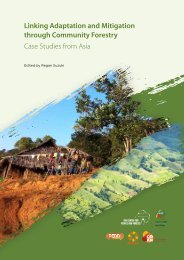Desktop Study on - Regional Climate Change Adaptation ...
Desktop Study on - Regional Climate Change Adaptation ...
Desktop Study on - Regional Climate Change Adaptation ...
You also want an ePaper? Increase the reach of your titles
YUMPU automatically turns print PDFs into web optimized ePapers that Google loves.
Assessment of Capacity Gaps and Needs of South East Asia Countries<br />
in Addressing Impacts, Vulnerability and Adaptati<strong>on</strong> to <strong>Climate</strong> Variability and <strong>Climate</strong> <strong>Change</strong><br />
meters higher and move 100 - 200 km northwards<br />
in comparis<strong>on</strong> with present. Due to abnormal<br />
changes of rainfall intensity, flood inundati<strong>on</strong> and<br />
drought would occur more frequently. Significant<br />
cultivati<strong>on</strong> areas in Mek<strong>on</strong>g and Red River deltas<br />
would be under salt water due to sea level rise. The<br />
Central Highlands regi<strong>on</strong> may also be affected <strong>on</strong><br />
agricultural productivity because of the increase of<br />
severe weather events. The ec<strong>on</strong>omy of the Central<br />
Highlands regi<strong>on</strong> of Viet Nam is based <strong>on</strong> forestry<br />
and agriculture in which the main products of the<br />
area includes coffee, rubber, pepper and other cash<br />
crops (ICEM, 2009).<br />
According to the results from the simulati<strong>on</strong>s, the<br />
period of inundati<strong>on</strong> will be prol<strong>on</strong>ged during the<br />
rainy seas<strong>on</strong> impacting the productivity of rice<br />
farming. As a rough estimati<strong>on</strong> of the effects of the<br />
inundati<strong>on</strong>s, at least 25% of the lands of the delta<br />
will be inundate in next decades, reducing the<br />
producti<strong>on</strong> by 3 milli<strong>on</strong> t<strong>on</strong>s of rice (ADPC, 2003).<br />
The Snidv<strong>on</strong>gs study (2006) c<strong>on</strong>tains the <str<strong>on</strong>g>Study</str<strong>on</strong>g><br />
of Impact of <strong>Climate</strong> <strong>Change</strong> <strong>on</strong> Rain-Fed Rice<br />
Productivity which argues that change in climate<br />
pattern will affect agriculture system directly,<br />
especially the rain-fed system. This study focused <strong>on</strong><br />
the study of climate change impact <strong>on</strong> rain-fed rice<br />
cultivati<strong>on</strong> as it is c<strong>on</strong>sidered as the most important<br />
food crop of the Southeast Asia regi<strong>on</strong>. It says that<br />
in Lower Mek<strong>on</strong>g River regi<strong>on</strong>, in Viet Nam, where<br />
farmers grow two crop cycles in a year, the simulati<strong>on</strong><br />
result of the study shows different climate impacts:<br />
the winter-spring crop will get slight impact from<br />
climate change as the yield will increase slightly<br />
from baseline year under climate c<strong>on</strong>diti<strong>on</strong>s at<br />
atmospheric CO2 c<strong>on</strong>centrati<strong>on</strong> of 540 ppm, but<br />
will drop slightly from baseline year under climate<br />
c<strong>on</strong>diti<strong>on</strong>s at CO2 c<strong>on</strong>centrati<strong>on</strong> of 720 ppm; the<br />
summer-autumn crop tends to be severely impacted<br />
by climate change. The simulati<strong>on</strong> shows significant<br />
decline productivity by approximately 8 - 12% under<br />
climate c<strong>on</strong>diti<strong>on</strong> at CO2 c<strong>on</strong>centrati<strong>on</strong> of 540 ppm<br />
and would sharply drop up to almost 50% in some<br />
areas under climate c<strong>on</strong>diti<strong>on</strong> at CO2 c<strong>on</strong>centrati<strong>on</strong><br />
of 720 ppm.<br />
Due to salinisati<strong>on</strong>, climate change is also expected<br />
to narrow down area of agricultural land. A<br />
significant fracti<strong>on</strong> of agricultural land in the coastal<br />
plain, the Red River Delta and the Mek<strong>on</strong>g River<br />
Delta will be exposed to salt water intrusi<strong>on</strong> as a<br />
result of rising sea level if no resp<strong>on</strong>ding method is<br />
applied (MoNRE, 2008b). Dasgupta’s study (2007),<br />
shows that a 1-metre rise in sea level would affect<br />
approximately 5 % of Viet Nam’s land area, which<br />
would impact 7% of agriculture, and reduce GDP<br />
by 10%. Al<strong>on</strong>g with the short rainy periods will<br />
come l<strong>on</strong>ger dry seas<strong>on</strong>s which will compound the<br />
salinisati<strong>on</strong> problems that already exist. In 2003, the<br />
42% of the delta was affected by salinity intrusi<strong>on</strong>,<br />
which is the main limiting factor in agricultural<br />
producti<strong>on</strong>. Drinking shortages are also a problem<br />
for local people, so measures are needed to prevent<br />
further salinity intrusi<strong>on</strong>; the increase of run-off<br />
in rainy seas<strong>on</strong> leaves less freshwater for the dry<br />
seas<strong>on</strong> (ADPC, 2003).<br />
Vulnerabilities and Adaptati<strong>on</strong> in the<br />
Agriculture and Food Sector<br />
Coastal districts of Viet Nam c<strong>on</strong>centrate nearly a<br />
quarter of the total populati<strong>on</strong>, though <strong>on</strong>ly covers<br />
16% of land surface. Approximately, 58% of coastal<br />
z<strong>on</strong>e livelihoods are based <strong>on</strong> agriculture, fishing<br />
and aquaculture (Chaudhry and Ruysschaert,<br />
2007). Agriculture, forestry and fishery c<strong>on</strong>tribute<br />
28.7% to the GDP. The agricultural land is 7.37<br />
milli<strong>on</strong> hectares; gross output of food crops in rice<br />
equivalent is 26.2 milli<strong>on</strong> t<strong>on</strong>s (MoNRE, 2003).<br />
Listed below are measures described in the Initial<br />
Nati<strong>on</strong>al Communicati<strong>on</strong> for adaptati<strong>on</strong> to climate<br />
change:<br />
1. Development of crop patterns suitable to<br />
climate change.<br />
2. Effective use of irrigati<strong>on</strong> water.<br />
3. Upgrading of irrigati<strong>on</strong> system for agriculture.<br />
4. Development of new varieties that could stand<br />
against severe envir<strong>on</strong>mental c<strong>on</strong>diti<strong>on</strong>s.<br />
5. Reserve and storage of local crop varieties,<br />
establishing crop seed bank.<br />
6. Development of farming techniques appropriate<br />
to climate change.<br />
Adaptati<strong>on</strong> of rain-fed farmer to climate change<br />
results<br />
The evidence is clear: adaptati<strong>on</strong> measures begin at<br />
local scale. In the case of rain-fed rice farmers in Viet<br />
Nam, indigenous adaptati<strong>on</strong> measures are practiced<br />
at the household level. Community and nati<strong>on</strong>al<br />
level measures play limited role in reducing their<br />
climate risks. Community level measures in Viet<br />
Nam are very limited and have low effectiveness.<br />
Farmers c<strong>on</strong>sider measures implemented at the<br />
nati<strong>on</strong>al level as moderately effective. The farmlevel<br />
soluti<strong>on</strong>s are mainly efforts and investments to<br />
increase and sustain the productivity (c<strong>on</strong>structi<strong>on</strong><br />
and maintenance of small-scale irrigati<strong>on</strong> systems<br />
or embankments to protect their farmland from<br />
39

















